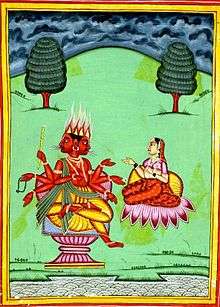Svaha
| Svaha | |
|---|---|
|
Goddess of Ash (Bhasm in hindi) Goddess of Afterlife, Hell, Motherhood, Life and Marriage | |
 Agni with Svaha | |
| Affiliation | Devi |
| Abode | Agniloka |
| Mantra | Om Svaha |
| Personal information | |
| Consort | Agni[1] |
| Parents |
Daksha Prasuti |
| Siblings | Sati |
In Hinduism and Buddhism, the Sanskrit lexical item svāhā (Romanized Sanskrit transcription; Devanagari: स्वाहा, chi. 薩婆訶, sà pó hē, jp. sowaka, tib. སྭཱཧཱ་, soha) is a denouement indicating the end of the mantra. Literally, it means "well said". In the Tibetan language, "svaha" is translated as "so be it" and is often pronounced and orthographically represented as "soha". Whenever fire sacrifices are made, svāhā is chanted. Etymologically, the term is probably from su, "well" and the root ah, "to call".
As a feminine noun, svāhā in the Rigveda may also mean "oblation" (to Agni or Indra), and as oblation personified, Svāhā is a minor Goddess and the wife of Agni. She was originally a nymph, but became immortal after marrying Agni. In some versions, she is one of the many divine mothers of Kartikeya. She is also the mother of Agneya (Aagneya) — the daughter of Agni. She is considered to be a daughter of Daksha and his consort Prasuti. She is thought to preside over burnt offerings. Her body is said to consist of the four Vedas and her six limbs are the six Angas of the Vedas. It is said that the gods to whom offerings are being made through yagna refuse the offerings unless the word 'svaha' is uttered during the sacrifice.
Story
In the Mahabharata Vana Parva, Markandeya narrates her story to the Pandavas. Svaha was the daughter of Daksha. She fell in love with the god of fire, Agni, and was pursuing him. Agni did not notice her. Agni presided over the sacrificial rituals of the Saptarshis. The god became highly besotted with the wives of the Saptarshis who were so attractive and beautiful, and kept staring at them.
Finally, Agni could not bear the guilt of longing for wives belonging to someone else and he went to the forests to perform penances. Svaha followed him and realised his desire. She took the forms of the wives of the Saptarshis (though she was unable to take the form of Arundhati, wife of Vashishtha) and approached Agni. Agni and Svaha spent many loving moments in the forest.
References
- ↑ Antonio Rigopoulos (1998). Dattatreya: The Immortal Guru, Yogin, and Avatara: A Study of the Transformative and Inclusive Character of a Multi-faceted Hindu Deity. State University of New York Press. p. 72. ISBN 978-0-7914-3696-7.
